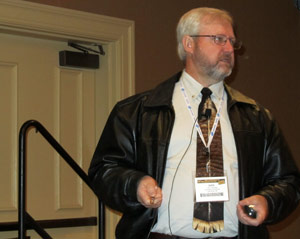300 Days of Grazing
Yes, it can be done.
by Kindra Gordon for Angus Productions Inc.
NASHVILLE, Tenn. (Feb. 1, 2012) — In 2008, the increasing cost of feed, fertilizer and fuel prompted University of Arkansas animal scientists and extension staff to re-evaluate what livestock producers could be doing in their state to curb costs and become more efficient.
They came up with an effort called the 300 Days Grazing Program. Today, it is helping producers save hundreds and thousands of dollars, reported Tom Troxel, animal science professor and associate department head at the University of Arkansas.

John Jennings
Overall, the program is helping producers be more efficient with pasture, hay and feed management without affecting their livestock production. On average, Arkansas producers feed hay for 135 days. University of Arkansas professor John Jennings said, “With our long growing season and forage options, there’s no reason we should have to feed hay that long.”
Jennings pointed out that many producers plan and manage for a hay crop — when they should plan and manage for a pasture crop that the livestock can harvest instead. He offered these four steps for anyone looking to streamline and add efficiency to their forage program:
- Start with an inventory of your forage base.
- Determine what management practices could be added to increase seasonal grazing from that forage base.
- Add complementary forages to fill in seasonal gaps.
- Plan forage and grazing practices ahead for the year.
From that, Jennings said, “Monitor and adjust your forages and livestock as needed.”
Among the strategies being employed by Arkansas producers are rotational and strip grazing; the addition of legumes; improved hay storage and feeding; as well as stockpiling of forages and planting winter annuals for fall and winter grazing.
Also important, said Jennings, is the use of soil testing to determine soil fertility needs to optimize forage production.
Utilizing electric fencing vs. permanent fences is another beneficial tool that allows producers flexibility with their grazing efforts.
Last but not least, Troxel emphasized that planning one or more seasons ahead is critical to success. “Planning helps ensure forage is available when the cows need it,” he concluded.
For more about U of A’s 300 Days Grazing Program and the grazing demonstration sites set up within the state, visit: http://www.aragriculture.org/forage_pasture/grazing_program/default.htm
-----------------------------
Editor’s Note: The above article was written under contract or by staff of Angus Productions Inc. (API). It may not be reprinted without express permission of API. To request reprint permision, contact the editor at 816-383-5200.
www.4cattlemen.com is an event coverage site provided by the editorial team at Angus Productions Inc. (API), publisher of the Angus Journal, the Angus Beef Bulletin, the Angus Beef Bulletin EXTRA and the Angus e-List. For questions about this site, to submit an article for our consideration, or to report a broken link, contact the editor at 816-383-5200; 3201 Frederick Ave., Saint Joseph, MO 64506.
API claims copyright to this web site as presented. We welcome educational venues and cattlemen to link to this site as a service to their audience.

